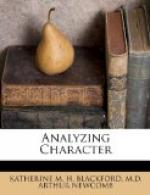HOW TO LEARN AND APPLY THE SCIENCE OF CHARACTER ANALYSIS
There are two ways to learn any science.
The first is to begin by collecting all possible facts, recording them and verifying them under all possible conditions, until they are as thoroughly established as any facts can be in our imperfect human understanding. The collection of facts in this way requires the most painstaking research, oftentimes including many thousands of observations. When all the facts have been thus collected and verified, they are classified. Then they are carefully analyzed and an effort is made to find some of the laws which underlie them. Perhaps, instead of a definite law, all that can be at first advanced is a hypothesis or theory. This hypothesis or theory having been formulated, many thousands of observations are taken in an effort to establish it as a definite law or a principle. Oftentimes whole new realms have to be explored before this can be determined. Sometimes, after a theory is advanced, perhaps seems to be approaching complete establishment, some fact or set of facts is discovered which compels the setting aside of all old theories and the formulation of a new one. When a theory has been definitely established as a law, other laws are sought in the same way until, finally, there are enough laws established to form the basis of a general principle. Then more laws and more principles are added in the same way until, finally, the body of knowledge has become sufficiently accurate, sufficiently definite and sufficiently organized and classified to be called a science.
HOW SCIENCE SLOWLY EVOLVES
This is the way in which all of the sciences known to man were first learned; that is to say, they were learned by their formulators coincident with the process of their formulation. This is a slow and laborious process of learning. Few, if any, sciences have ever been thus mastered by any one individual. Indeed, the certain establishment of a very few facts, or, perhaps, only one important fact, the formulation of a theory, or the final statement of a law is usually the limit of the contribution of any one person to any science.
No science is independent. The science of physics, for example, could never have reached its present-day state of development if it had not laid heavy tribute upon the sciences of mathematics, astronomy, chemistry, geography, mechanics, optics, and others. In a similar way, the science of character analysis has derived many of its facts, laws, and even principles, from the sciences of physics, chemistry, biology, anthropology, ethnology, geography, geology, anatomy, physiology, histology, embryology, psychology, and others. Since this is true, it is obvious that the work of collecting, verifying, classifying, analyzing, and organizing the facts upon which the science of character analysis is based has been going on from




